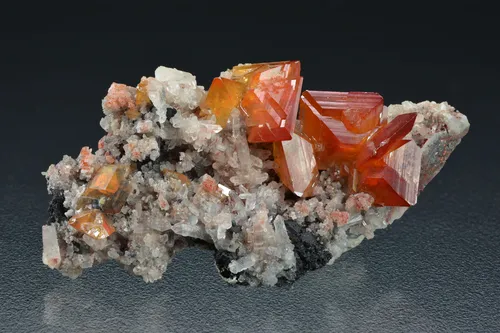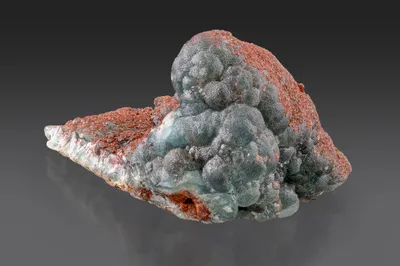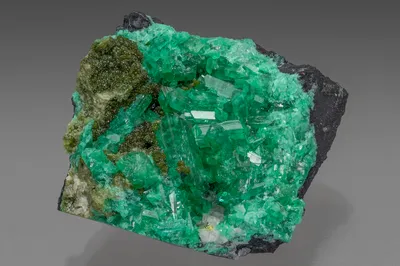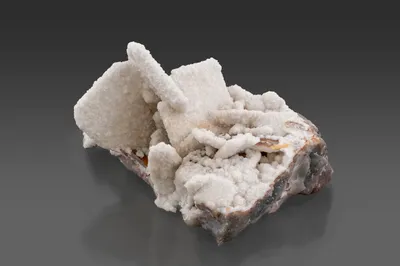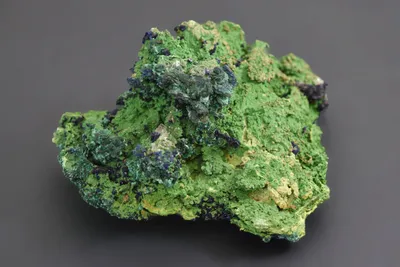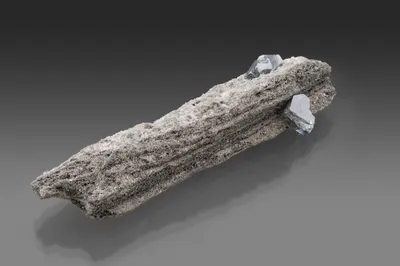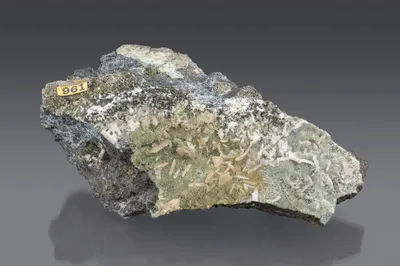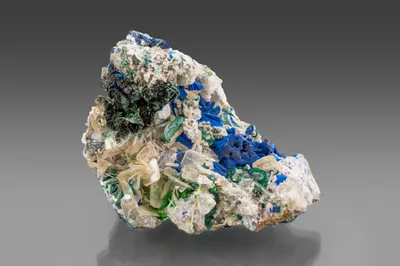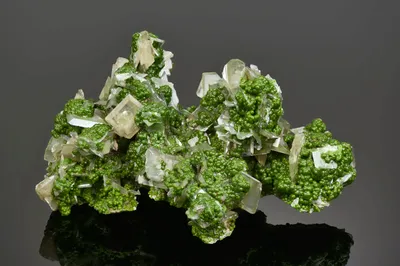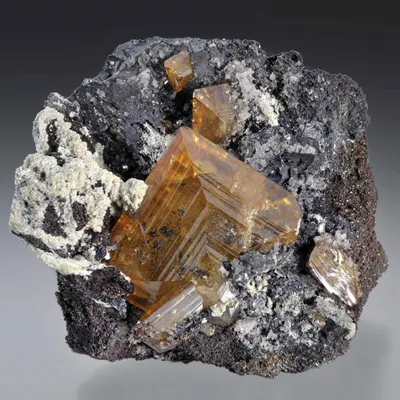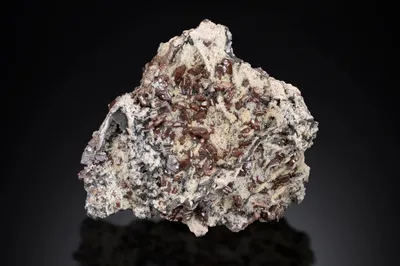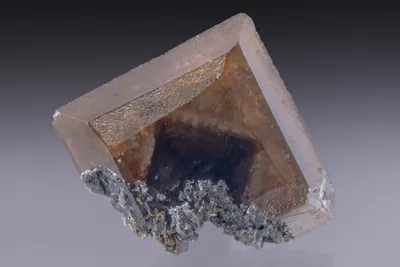
Image Credit: Bruce Cairncross
Mineral Species
Wulfenite
Type Locality
No
Composition
PbMoO4
Crystal System
Tetragonal
Status at Tsumeb
Confirmed
Abundance
Common
Distribution
First, second and third oxidation zones
Paragenesis
Supergene
Entry Number
Species; TSNB375
General Notes
Wulfenite was present, though somewhat inconspicuous, in the first oxidation zone. Neither Schneider (1906), Maucher (1908) nor Schneiderhöhn (1929) included wulfenite in their lists of mineral species. Klein (1938), however, described wulfenite as relatively common in the upper levels of the mine. One of the few inconsistencies in Klein’s mineralogical legacy is that his specimen catalogue (unpublished document; Klein family archive) attributes the wulfenites in his collection to 6 Level, 9 Level and 11 Level, while his published notes (Klein 1938) state that wulfenite was "unknown" below 160 m depth (= 6 Level). He noted, however, that beautiful crystals of wulfenite were found, particularly in the Nebentrümern (a side-shoot of the main ore body in the first oxidation zone).
Ramdohr (1939), in republishing Klein’s (1938) notes for the German scientific community, added a comment that "wulfenite is much more common than previously thought." It is therefore puzzling that Strunz et al. (1958a), some 30 years later, did not include wulfenite in their list of the secondary minerals considered to be common in the upper levels of the mine.
By far the best Tsumeb wulfenite specimens were recovered from the second oxidation zone, with many important discoveries in the 1960s and 1970s. Keller (1977a), in a study of mineral specimens from the second oxidation zone, ranked wulfenite as the eighth most commonly encountered secondary mineral.
Unfortunately, the exact locations from which specimens originated were seldom recorded, although there are a few exceptions to this. Wilson (1979, page 115) figured a very large crystal of pale grey wulfenite attributed to the East 95 Stope on 28 Level, while the unpublished records and specimen labels of Walther Bartelke (now in the collection of Uli Bahmann) indicate that, in the mid-1970s, Bartelke collected "wulfenite with malachite" and "cerussite with wulfenite and malachite," both from the East 65 Stope on 28 Level; "wulfenite on tennantite crystals" from 32 Level; "dioptase with wulfenite" from the East 19 Stope on 32 Level; and "yellow wulfenite crystals with cerussite" from the West 80 Stope, also on 32 Level. So, although the information is far from complete, it appears that the interval between 28 and 32 levels (i.e. between depths of 880 and 1,040 meters below the surface) was a productive zone for this species.
According to Gebhard (1999), the third oxidation zone "… did not produce any significant [wulfenite] crystals", however, the combination pieces of dioptase with chromate-yellow wulfenite from the third oxidation zone are most certainly noteworthy.
While it cannot really be claimed that Tsumeb has produced the world's best wulfenite specimens, the variety of colour and habit for wulfenite at Tsumeb is unmatched by any other single locality (Southwood 2019).
Tsumeb wulfenites are most commonly tabular with few crystallographic forms; the c-pinacoid {001} is dominant, with small first-order pyramids providing narrow, single-stage (and sometimes two-stage) bevelled edges to the crystals. As the pyramid faces become larger, thicker tabular crystals result and eventually, but a little less commonly, dipyramidal (or pseudo-octahedral) crystals are observed with the basal pinacoid much reduced or even absent (Southwood 2019).
Steep dipyramidal crystals are uncommon at Tsumeb and only very rarely is the a-pinacoid {100} observed as a prominent form.
A specimen in the Natural History Museum, London (catalogue number BM.1932,1081) includes small wulfenite crystals of prismatic habit (to 3 mm in length), terminated by a pyramid and c-pinacoid. This very unusual wulfenite habit is accompanied by smithsonite and cerussite in a vug in oxidising sulphide ore. The specimen label reads: "Presd. [= presented] by Wilhelm Klein, Esq., of Tsumeb, S. W. Africa, June 1932". Clearly, Klein considered this atypical habit significant.
One of the two habits presented by blue wulfenite at Tsumeb (see below), is hemimorphic and comprises a combination of first- and second-order prisms and pyramids.
According to Pinch and Wilson (1977) Tsumeb wulfenite "…ranges from colorless and clear to very pale brown, pink and yellow, orange, brownish red, sherry-brown, greenish brown, light blue and very dark blue." Grey and (less commonly) white crystals are also observed.
Blue wulfenite is rare at Tsumeb (and globally) but highly prized by collectors and it has attracted considerable attention in the literature. At least three types of blue wulfenite have been described:
- Blue wulfenite was first reported at Tsumeb by Geier (1973/74) and later found to contain up to 12 percent tungsten (pers. comm. from W. Kahn to W. Bartelke, cited in Bartelke [1976]). Pinch and Wilson (1977) described these tabular crystals as "chillagite" with the colour ranging from blue to colourless and apparently unrelated to the tungsten content. They suggested that "… the blue color may be due to inclusions of ilsemannite (Mo3O8·nH2O)", but this hypothesis does not appear to have been investigated further.
- Keller (1984) noted that not all tabular blue wulfenites show significant tungsten enrichment.
- Embrey et al. (1977a) examined blue wulfenite crystals of the pyramidal-prismatic habit and found them "… in no way comparable to ‘chillagite’ in color, habit or WO3 content." They observed that the crystals are hemimorphic with a complex pyramidal termination developing at only one end of each crystal. The crystals have brown cores, "… overlain by blue wulfenite around the prism and lower pyramid, while the tips of the crystals and perhaps the whole outer surface are essentially colorless." The WO3 content of these crystals ranged from 0.25 to 1.3 wt %, an order of magnitude less than in the blue crystals of tabular habit; furthermore, there was no detectable difference in composition between the zones of different colour. They hypothesised that the blue colour is caused by partial reduction of Mo6+ to Mo4+.
Keller (1977a) considered that wulfenite crystallises in a pH range of 5 – 6, intermediate between the conditions for his Type I (near neutral) and Type II (acidic) parageneses. He included wulfenite in two of his Type I parageneses, and in one of his "Rare parageneses" sequences: I/4: goethite >> wulfenite >> mimetite >> malachite I/5: hematite >> goethite >> wulfenite (i) >> duftite >> calcite >> wulfenite (ii) R/1: sulphides >> wulfenite >> alamosite >> kegelite >> leadhillite >> cerussite Keller (1977a) noted that duftite, goethite; malachite, mimetite and quartz are the most important secondary minerals occurring with wulfenite.
Associated Minerals
alamosite; anglesite; aragonite; arsendescloizite; arsentsumebite; azurite; bayldonite; beudantite; biehlite; brucite; calcite; cerussite; conichalcite; copper; cuprite; descloizite; devilline; dioptase; duftite; dolomite; feinglosite; gartrellite; goethite; graphite; hematite; ilsemannite (?); kaolinite; kegelite; krieselite; larsenite; lavendulan; leadhillite; lukrahnite; malachite; mawbyite; melanotekite; metazeunerite; mimetite; molybdofornacite; mottramite; oxyplumbomoréite; paradamite; parkinsonite; phlogopite; plancheite; plumbotsumite; pyromorphite; quartz; queitite; rhodochrosite (?); rosasite; schultenite; scorodite; sepiolite; serpierite; smithsonite; tennantite-(Zn); tenorite; tsumcorite; willemite; witherite; zincgartrellite; zincolivenite
Pseudomorphs
The following minerals are reported to form pseudomorphs after wulfenite: bayldonite (rare); conichalcite (rare); dolomite (rare); duftite (rare); malachite (rare); mottramite (rare); quartz (rare); smithsonite (rare); stolzite (rare).
